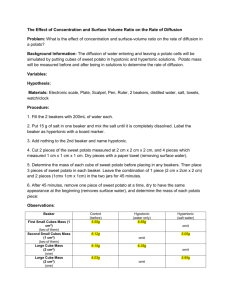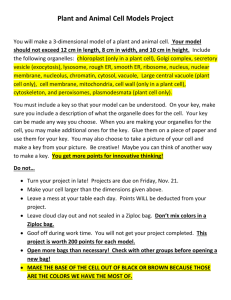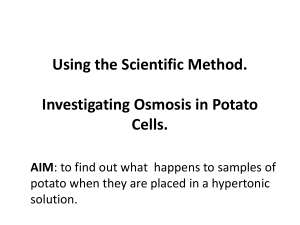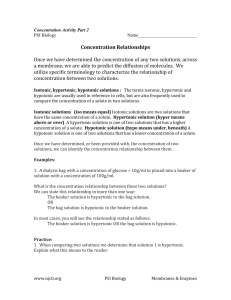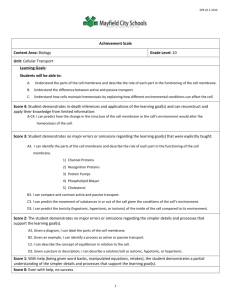LAB EXERCISE VII: Diffusion
advertisement
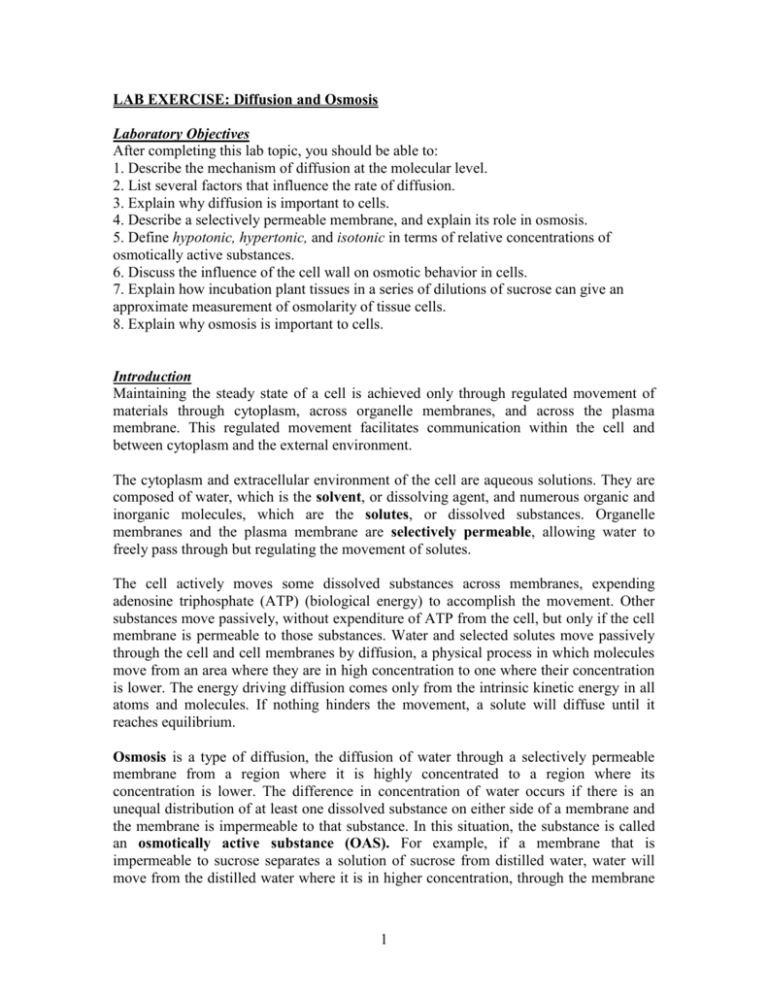
LAB EXERCISE: Diffusion and Osmosis Laboratory Objectives After completing this lab topic, you should be able to: 1. Describe the mechanism of diffusion at the molecular level. 2. List several factors that influence the rate of diffusion. 3. Explain why diffusion is important to cells. 4. Describe a selectively permeable membrane, and explain its role in osmosis. 5. Define hypotonic, hypertonic, and isotonic in terms of relative concentrations of osmotically active substances. 6. Discuss the influence of the cell wall on osmotic behavior in cells. 7. Explain how incubation plant tissues in a series of dilutions of sucrose can give an approximate measurement of osmolarity of tissue cells. 8. Explain why osmosis is important to cells. Introduction Maintaining the steady state of a cell is achieved only through regulated movement of materials through cytoplasm, across organelle membranes, and across the plasma membrane. This regulated movement facilitates communication within the cell and between cytoplasm and the external environment. The cytoplasm and extracellular environment of the cell are aqueous solutions. They are composed of water, which is the solvent, or dissolving agent, and numerous organic and inorganic molecules, which are the solutes, or dissolved substances. Organelle membranes and the plasma membrane are selectively permeable, allowing water to freely pass through but regulating the movement of solutes. The cell actively moves some dissolved substances across membranes, expending adenosine triphosphate (ATP) (biological energy) to accomplish the movement. Other substances move passively, without expenditure of ATP from the cell, but only if the cell membrane is permeable to those substances. Water and selected solutes move passively through the cell and cell membranes by diffusion, a physical process in which molecules move from an area where they are in high concentration to one where their concentration is lower. The energy driving diffusion comes only from the intrinsic kinetic energy in all atoms and molecules. If nothing hinders the movement, a solute will diffuse until it reaches equilibrium. Osmosis is a type of diffusion, the diffusion of water through a selectively permeable membrane from a region where it is highly concentrated to a region where its concentration is lower. The difference in concentration of water occurs if there is an unequal distribution of at least one dissolved substance on either side of a membrane and the membrane is impermeable to that substance. In this situation, the substance is called an osmotically active substance (OAS). For example, if a membrane that is impermeable to sucrose separates a solution of sucrose from distilled water, water will move from the distilled water where it is in higher concentration, through the membrane 1 into the sucrose solution, where it is in lower concentration. In this case, sucrose is the osmotically active substance. Three terms, hypertonic, hypotonic, and isotonic, are used when referring to two solutions separated by a selectively permeable membrane. The hypertonic solution has a greater concentration of OAS than the solution on the other side of the membrane. It is described, therefore, as having a greater osmolarity (solute concentration expressed as molarity). The hypotonic solution has a lower concentration of OAS, or a lower osmolarity, than the solution on the other side of the membrane. When the two solutions are in equilibrium, the concentration of OAS being equal on both sides of the membrane, the osmolarities are equal and the substances are said to be isotonic. The net flow of water is from the hypotonic to the hypertonic solution. When the solutions are isotonic, there is no net flow of water across the membrane. The concept of osmotic pressure must be understood when studying osmosis. The movement of water from a hypotonic solution through the membrane into a hypertonic solution can be prevented by applying force or pressure on the hypertonic side. The force that must be applied to prevent osmotic movement of water from hypotonic to hypertonic, measured in atmospheres, is referred to as osmotic pressure. Solutions with greater concentrations of OAS have greater osmotic pressures because greater force is required to prevent water movement into them. Distilled water has an osmotic pressure of zero. EXERCISE 1. Diffusion of Molecules Through a Selectively Permeable Membrane Materials string or rubber band sharpie 30 % glucose solution starch solution I2KI solution Benedict’s reagent hot plate 500 – mL beaker one-third filled water handheld test tube holder 3 standard test tubes disposable transfer pipettes 2 400 – mL beakers to hold dialysis bag 30 – cm strip of moist dialysis tubing Introduction Dialysis tubing is a membrane made of regenerated cellulose fibers formed into a flat tube. If two solutions containing dissolved substances of different molecular weights are separated by this membrane, some substances may readily pass through the pores of the membrane, but others may be excluded. Working in groups of four students, you will investigate the selective permeability of dialysis tubing. You will test the permeability of the tubing to glucose, starch (a variablelength polymer of glucose), and iodine potassium iodide (I2KI). You will place a solution of glucose and starch into a dialysis tubing bag and then place this bag into a solution of 2 I2KI. Sketch and label the design of this experiment in the margin of your lab manual to help you develop your hypotheses. You will use two tests in your experiment: 1. I2KI test for presence of starch. When I2KI is added to the unknown solution, the solution turns purple or black if starch is present. If no starch is present, the solution remains a pale yellow-amber color. 2. Benedict’s test for reducing sugar. When Benedict’s reagent is added to the unknown solution and the solution is heated, the solution turns green, orange, or orange-red if a reducing sugar is present (the color indicates the sugar concentration). If no reducing sugar is present, the solution remains the color of Benedict’s reagent (blue). Hypothesis Hypothesize about the selective permeability of dialysis tubing to the substances being tested. Prediction Predict the results of the I2KI and Benedict’s tests based on your hypothesis (if/then). Procedure 1. Fold over 3 cm at the end of a 25 - to 30 – cm piece of dialysis tubing that has been soaking in water for a few minutes, pleat the folded end “accordion style,” and close the end of the tube with the string or a rubber band, forming a bag. This procedure must secure the end of the bag so that no solution can seep through. 2. Roll the opposite end of the bag between your fingers until it opens, and add 4 pipettes full of 30% glucose into the bag. Then add 4 pipettes full of starch solution to the glucose in the bag. 3. Hold the bag closed and mix its contents. Record its color in Table 1. Carefully rinse the outside of the bag in tap water. 4. Add 300 mL of water to a 400 to 500 ml beaker. Add several droppers full of I2KI solution to the water until it is visibly yellow-amber. Record the color of the H20 + I2KI solution in Table 1. 5. Place the bag in the beaker so that the untied end of the bag hangs over the edge of the beaker (Figure 1). Do not allow the liquid to spill out of the bag! If the bag is too full, remove some of the liquid and rinse the outside of the bag again. If needed, place a rubber band around the beaker, holding the bag securely in place. If some of the liquid spills into the beaker, dispose of the beaker water, rinse, and fill again. 3 6. Leave the bag in the beaker for 30 minutes. (You should go to another lab activity and then return to check your setup periodically.) 7. After 30 minutes, carefully remove the bag and stand it in a dry beaker. 8. Record the final color of the solution in the bag and the final color of the solution in the beaker in Table 1. 9. Perform the Benedict’s test for the presence of sugar in the solutions. a. Label three clean test tubes: control, bag, and beaker. b. Put 2 pipettes full of water in the control tube. c. Put 2 pipettes full of the solution from the bag in the bag tube. d. Put 2 pipettes full of the solution from the beaker in the beaker tube. e. Add 1 dropper full of Benedict’s reagent to each tube. f. Heat the test tubes in a boiling water bath for about 3 minutes. g. Record your results in Table 2. Figure 1. Setup for Exercise 1. The dialysis tubing bag, securely closed at one end, is placed in the beaker of water and I2KI. The open end of the bag should drape over the edge of the beaker. Results Table 1. Results of Experiment Investigating the Permeability of Dialysis Tubing to Glucose, I2KI, and Starch. 4 Solution Source Original Contents Original Color Final Color Bag Beaker Table 2. Results of Experiment Investigating the Permeability of Dialysis Tubing to Glucose, I2KI, and Starch Following Benedict’s Test Solution Source Color prior to Benedict’s Test Color after Benedict’s Test Bag Beaker Control Discussion 1. From your results, predict the size of I2KI molecules relative to glucose and starch. 2. What colors would you expect if the experiment started with glucose and I2KI inside the bag and starch in the beaker? Explain. 5 EXERCISE 2. Estimating the Osmolarity of Plant Cells by Change in Weight Frequently, plant scientists need to determine the optimum water content for normal physiological processes in plants. They know that for normal activities to take place, the amount of water relative to osmotically active substances in cells must be maintained within a reasonable range. If plant cells have reduced water content, all vital functions slow down. In the following experiments, you will estimate the osmolarity of potato tuber cells. You will incubate pieces of potato tuber in sucrose solutions of known molarity. The object is to find the molarity at which weight of the potato tuber tissue does not change, indicating that there has been no net loss or gain of water. This molarity is an indirect measure of the osmolarity of the potato tuber. Materials 1 large potato tuber 7 250-mL beakers Sharpie forceps balance metric ruler petri dish sucrose solutions: 0.1, 0.2, 0.3, 0.4, 0.5, 0.6 M razor blade cork borer deionized (DI) water (0 molar) paper towels aluminum foil Introduction In this experiment, you will determine the weight of several potato tuber cylinders and incubate them in a series of sucrose solutions. After the cylinders have incubated, you will weigh them and determine if they have gained or lost weight. This information will enable you to estimate the osmolarity of the potato tuber tissue. Hypothesis Hypothesize about the osmolarity of potato tuber tissue. Prediction Predict the results of the experiment based on your hypothesis (if/then). Procedure 1. Label 7 beakers as follows: 0.0M, 0.1M, 0.2M, 0.3M, 0.4M, 0.5M and 0.6M. 2. Add 100 mL of the sucrose solutions to the correct beaker. (Note: DI water is 0.0M). 6 3. Use a sharp cork borer to obtain seven cylinders of potato. Push the borer through the length of the potato, twisting it back and forth. When the borer is filled, remove from the potato and push the potato cylinder out of the borer. You must have seven complete, undamaged cylinders which are at least 5 cm long. *Cork borers and razor blades can cut! Use them with extreme care! To use the cork borer, hold the potato in such a way that the borer will not push through the potato in your hand. 4. Line up the potato cylinders and, using a sharp razor blade, cut all cylinders to a uniform length, about 5 cm, removing the peel from the ends. 5. Place all seven potato samples in a petri dish, and keep them covered to prevent their drying out. *In subsequent steps, treat each sample individually. Work quickly. To provide consistency, each person should do one task to all cylinders (one person wipe, another weigh, another slice, another record data). 6. Remove a cylinder from the petri dish, and place it between the folds of a paper towel to blot sides and ends. 7. Weigh it to nearest 0.01 g on the aluminum sheet on the balance. Record the weight in Table 1 in the Results section. 8. Immediately cut the cylinder lengthwise into two long halves. 9. Transfer potato pieces to the water beaker. 10. Note what time the potato pieces are placed in the water beaker. Time _______ 11. Repeat steps 6 to 8 with each cylinder, placing potato pieces in the appropriate incubating solution from 0.1 to 0.6 M. *Be sure that the initial weight of the cylinder placed in each test solution is accurately recorded. 12. Incubate 1.5 hours. (As this takes place, you will be performing other lab activities.) 13. Swirl each beaker every 10 to 15 minutes as the potato pieces incubate. 14. At the end of the incubation period, record the time when the potato pieces are removed. Time: _______. Record the approximate incubation time in Table 1. 15. Remove the potato pieces from the first sample. Blot the pieces on a paper towel, removing excess solution only. 16. Weigh the potato pieces and record the final weight in Table 1. 17. Repeat this procedure until all samples have been weighed in the chronological order in which they were initially placed in the test solutions. 18. Record your data in the Results section. 7 Results Table 1. Data for Experiment Estimating Osmolarity by Change in Weight Sucrose Molarity 0.0 0.1 0.2 0.3 0.4 0.5 0.6 Final weight (g) Initial weight (g) Weight change (g) % change in weight To calculate percentage change in weight, use this formula: Percentage change in weight = weight change X 100 initial weight If the sample gained in weight, the value should be positive. If it lost in weight, the value should be negative. Discussion 1. At what sucrose molarity does the curve cross the zero change line on the graph? 2. Explain how this information can be used to determine the osmolarity of the potato tuber tissue. 3. Estimate the osmolarity of the potato tuber tissue. EXERCISE 3. Osmotic Activity in Cells All organisms must maintain an optimum internal osmotic environment. Terrestrial vertebrates must take in and eliminate water using internal regulatory systems to ensure that the environment of tissues and organs remains in osmotic balance. Exchange of waste and nutrients between blood and tissues depends on the maintenance of this condition. Plants and animals living in fresh water must control the osmotic uptake of 8 water into their hypertonic cells. In this exercise, you will investigate the osmotic behavior of plant and animal cells placed in different molar solutions. Part 1: Osmotic Behavior of Animal Cells Materials clean microscope slides coverslips sharpie dropper bottle of ox blood dropper bottles with three solutions of unknown osmolarity Introduction Mature red blood cells (erythrocytes) are little more than packages of hemoglobin bound by a plasma membrane permeable to small molecules, such as oxygen and carbon dioxide, but permeable to larger molecules, such as proteins, sodium chloride, and sucrose. In mammals these cells even lack nuclei when mature, and as they float in isotonic blood plasma, their shape is flattened and pinched inward into biconcave disk. Oxygen and carbon dioxide diffuse across the membrane, allowing the cell to carry out its primary function, gas transport, which is enhanced by the increased surface area created by the shape of the cell. When water moves into red blood cells placed in a hypotonic solution, the cells swell and the membranes burst, or undergo lysis. When water moves out of red blood cells placed in a hypertonic solution, the cells shrivel and appear bumpy, or crenate (Figure 1). In this experiment, you will investigate the behavior of red blood cells when the osmolarity of the environment changes from isotonic to hypertonic or hypotonic. Figure 1. Red blood cell placed in solutions of varying osmolarity. A. Isotonic solution, B. Hypertonic solution, C. Hypotonic solution. Procedure 1. Label four clean microscope slides A, B, C and D. 2. Place a drop of blood on slide D, cover with a coverslip and observe the shape of red blood cells with no treatment. Record you observations in Table 2. 9 3. Place a drop of solution A on slide A and add a coverslip. Place the slide on the microscope stage and carefully add a small drop of blood to the edge of the coverslip. The blood cells will be drawn under the coverslip by capillary action. 4. As you view through the microscope, carefully watch the cells as they come into contact with solution A; record you observations in Table 2. 5. Repeat steps 3 and 4 with solutions B and C. 6. Record you observations in Table 2. Results Table 2. Appearance of Red Blood Cells in Test Solutions. Solution Appearance/Conditions of Cells D (blood only) A B C Discussion 1. Based on your results, which of the three solutions is hypertonic to the red blood cells? Hypotonic? Isotonic? Part 2: Osmotic Behavior in Cells with a Cell Wall Materials clean microscope slides coverslips sharpie Elodea leaves dropper bottles with three solutions of unknown osmolarity Introduction In their natural environment, cells of freshwater plants and algae are bathed in water with a little OAS. The net flow of water is from the surrounding medium into the cells. To understand this process, review the structure of Elodea cells from the microscopy lab. 10 The presence of a cell wall and a large fluid-filled central vacuole in a plant or algal cell will affect the cell’s response to solutions of differing molarities. When a plant cell is placed in a hypertonic solution, water moves out of the cell; the protoplast shrinks and may pull away from the cell wall. This process is called plasmolysis, and the cell is described as plasmolyzed (Figure 2). In a hypotonic solution, as water moves into the cell and ultimately into the cell’s central vacuole, the cell’s protoplast (the plant cell exclusive of the cell wall – the cytoplasm enclosed by plasma membrane) expands. The cell wall, however, restricts the expansion, resulting in turgor pressure (pressure of the protoplast on the cell wall owing to uptake of water). A high turgor pressure will prevent further movement of water into the cell. This process is a good example of the interaction between pressure and osmolarity in determining the direction of the net movement of water. The hypertonic condition in the cell draws water into the cell until the membraneenclosed cytoplasm presses against the cell wall. Turgor pressure begins to force water through the membrane and out of the cell, changing the direction of net flow of water. Figure 2. The effect of turgor pressure on the cell wall and the direction of net flow of water in a plant cell. A plant cell undergoes changes in a hypotonic solution. (a.) Low turgor pressure. The net flow of water comes into the cell from the surrounding hypotonic.medium. (b). Turgor pressure increases. The protoplast begins to press on the cell wall. (c). Greatest turgor pressure. The tendency to take up water is ultimately restricted by the cell wall, creating a back pressure on the protoplast. Water enters and leaves the cell at the same rate. Procedure 1. Label three clean microscope slides A, B, and C. 2. Prepare slide C with one of the youngest (smallest) leaves from a sprig of Elodea under the compound microscope. 3. Record your observations in Table 3. 4. Prepare slide A with an Elodea leaf and a drop of solution A. Record your observations. 5. Prepare slide B with an Elodea leaf and a drop of solution B. Record your observations. 11 Results Table 3. Appearance of Elodea Cells in Unknown Solutions A and B. Solution Appearance/Conditions of Cells A B C Discussion 1. Based on your observations, which solution is hypertonic? Hypotonic? 2. Which solution has the greatest osmolarity? 3. Would you expect pond water to be isotonic, hypertonic, hypotonic to Elodea cells? Explain. 12
